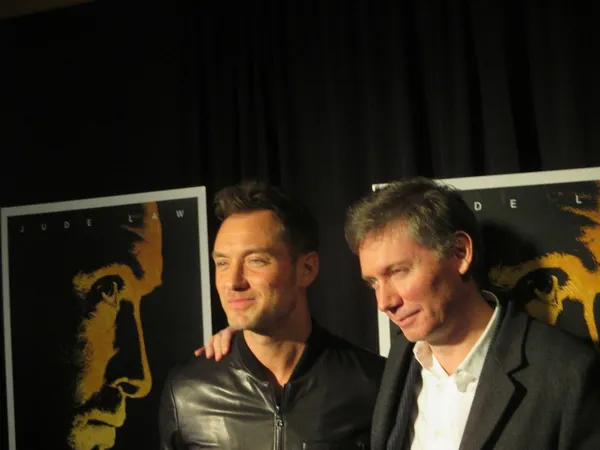Caroline Champetier told me that she understood the "language of cinematography" after seeing the way Vilmos Zsigmond "lit" Robert Altman's The Long Goodbye, starring Elliott Gould. In our conversation the importance of a Robert Bresson ending, Ingmar Bergman's influence, and lessons from Jean Renoir, Roberto Rossellini and Jean-Luc Godard come to light.
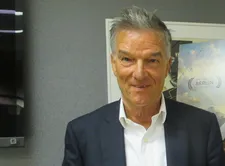 |
| On Benoît Jacquot's La Désenchantée, La Fille Seule and À Tout De Suite: "Each time he was in love with the girl. It's a good way to make a good movie, to be in love." Photo: Anne-Katrin Titze |
Caroline's work with Arnaud Desplechin (La Sentinelle); Anne Fontaine (The Innocents, Oh La La!, Dry Cleaning); Chantal Akerman (Toute Une Nuit); Leos Carax and his star Denis Lavant (Tokyo!, Holy Motors); Benoît Jacquot (La Désenchantée, La Fille Seule, The Untouchable, Villa Amalia, À Tout De Suite); Jacques Rivette (Le Pont Du Nord, Céline Et Julie Vont En Bateau, La Bande Des Quatre), and Xavier Beauvois (Of Gods And Men, Le Petit Lieutenant, To Matthieu, Don't Forget You're Going To Die, The Price Of Fame, The Guardians) - these films for her are "journeys" that include spending time with directors to come up with "what could be the picture of the movie".
We start out by discussing her inspirations and where they take her.
Anne-Katrin Titze: Different directors, I suppose, give you different inspirations for moods they want to create. Works of art, other films.
Caroline Champetier: Of course, doing movies are journeys. So you spend time with the director, you speak, you see movies, you see pictures, you see paintings, you go to the museum. You are going on a journey not to have exactly the pictures of the movie but to have in mind something that gives you what could be the picture of the movie.
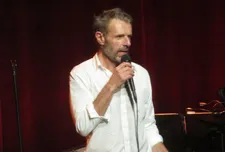 |
| Caroline Champetier on her reference for Xavier Beauvois' Of Gods And Men starring Lambert Wilson: "I had the Rembrandt self-portraits." Photo: Anne-Katrin Titze |
AKT: Because it's so fragile.
CC: It is, it is! But you can have a straight and strong reference. For example in The Innocents, Bergman or Vilhelm Hammershøi who is a Danish painter. It's a really strong reference of the movie.
Then for [Xavier Beauvois'] Of Gods And Men [Des Hommes Et Des Dieux], I had the Rembrandt self-portraits. There are something like 80. It's amazing to understand how this painter is looking at himself. He is not friendly with himself. This conducted me to the way to look at these men.
AKT: In The Innocents, there is one image that for me is at the centre of this film - that is the cross and the baby in the basket. The entire film is like a snow flower, something that emanates from this kernel image. I've seen the film a while ago and thinking back, all the other images come from that. Was this image central in your discussions with the director [Anne Fontaine]?
CC: What is important I think, and you describe it very well, it's because it's one shot. She's coming from the forest, we follow her, we see the cross and she's going to the cross and we see her putting the basket - one shot. And just after we understand and we know that in this basket there is the baby. It's like a fairy tale, you see. And I think the reason why you have it in mind is because from the beginning Anne and I wanted to tell the story but not to judge.
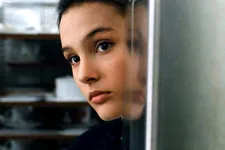 |
| Virginie Ledoyen in La Fille Seule (A Single Girl): "With Benoît Jacquot it's not at all chaos. It's very prepared." |
To have a distance with the story and to tell the fairy tale. It's a good way to have this distance. Of course, in that shot she's a bad woman, the superior of the convent, because it's representation you see. But when you see her at the end of the movie it's a real woman with suffering who knows she was wrong. And the last shot for me was really important, like a Robert Bresson picture. Something really deep.
So you have two levels in the movie. You have the level telling the story and this like a fairy tale because it's too awful to go to the realism. And you have the way not to judge the characters and to go with them till the end. And for me and Anne it was really important to stay beside the characters, not to judge.
AKT: It's the abyss that opens up at the moment I was describing, the one with the cross, and we have to find our way again in the tale. A totally different type of tale is the Merde sequence you shot for Tokyo!. Which is so funny and unbelievably wild. Can you talk about how you were working with Leos Carax on this one and Holy Motors?
CC: There is one character in Holy Motors coming directly from Tokyo!
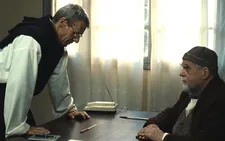 |
| Lambert Wilson and Michael Lonsdale in Of Gods And Men, shot by Caroline Champetier |
AKT: I know, he came back up from the sewers.
CC: It's like the shouting of Carax after something like over ten years without shooting. It's like this shout "merde!", you see. It's anger and as you say, funny anger with this character who is like a terrorist living in the sewers of Tokyo. It was very strange because be were like alone with Leos working with all these Japanese people, not speaking the language. So we were very close. It was a way to learn to be together.
I shot that with a very little camera I loved, Panasonic DVX 100. Very little tool, so I was able to be alone, the only crew. I think Leos loved that - to be free. We were not so free in Tokyo because shooting in Tokyo is very hard. But the language of the camera was totally free.
AKT: And then in Holy Motors you have everything, so many films in one. And on every level. It seems like that for you as cinematographer and also for costume, for makeup. A world packed into one film.
CC: It's absolutely right. It's like many movies together. I think it's a way to work. In front of a project you are not to say it's just one movie. It can be many movies! And this is a Godard lesson. Godard was always thinking about his movie is making a budget for a sequence and thinking about the sequence, not something easy or lazy.
_225.webp) |
| On Arnaud Desplechin's La Sentinelle: "We worked like we were making four or five movies together in one." Photo: Anne-Katrin Titze |
And it was exactly that we've done in Holy Motors - thinking about the sequence. And each sequence was a technical nightmare. To understand exactly what we wanted and then we worked for months to prepare. It was a very happy movie. But I think it was a very happy movie because we prepared so long before.
AKT: And so well! Just the limousine scenes alone!
CC: And so well! Absolutely. We were very lucky to work with Denis Lavant. Not all actors can be so concentrated, so brilliant and so involved. I think the movie can also be a bit of admiration for the actor, admiration to Denis Lavant. There is something between Carax and Denis Lavant that is very strong in this movie.
AKT: And already before. He has been a sort of alter ego.
CC: This can be the achievement of that.
AKT: When you work with actors, how often do their preferences enter into it? I am thinking of, for instance, I don't know, in the past Claudette Colbert only wanting her left profile shot and never her right.
CC: You work with that. I'm never against these kind of things. It can be true, it can be a bit fantasist but if it's the way they are, okay. We are here to give life to the character or to make the actor appear to be the character. For me it's important to give, to see, to reveal the beauty of the person. So I go the way it's better for them.
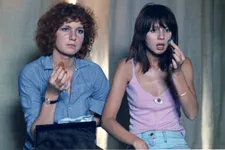 |
| Dominique Labourier and Juliet Berto in Jacques Rivette's Céline Et Julie Vont En Bateau |
AKT: I think it shows. Sometimes in movies I get the sense it's counterproductive.
CC: I understand very well. We have to be with. Because cinematography and cinema, it's a friendship art.
AKT: There should be some kindness.
CC: Yes. It's really important. It's the Renoir lesson, the Rossellini lesson. It cannot be like literature or like painting. You have to be with because it's the mystery of incarnation.
AKT: Do you remember the first time you saw a film and recognised there is something like cinematography?
CC: Yes, it was not so early. I was not from a family that used to go to the movies. It was when I started my studies of cinema in IDHEC, I saw The Long Goodbye by Robert Altman with Elliott Gould and it was lit by Vilmos Zsigmond. And I understood there is something of the language of cinematography that gave something very deep to the movie.
I remember very well thinking, oh yes, the DP can do that! So it's very important for the movie to have a good DP. Of course, afterwards I saw all the work of Vilmos Zsigmond and understood what an artist he was, what he gave to movies and I started on my way.
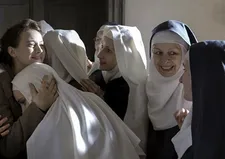 |
| On Anne Fontaine's The Innocents: "It's like a fairy tale, you see." |
AKT: When you worked with Arnaud Desplechin, on his first film, La Sentinelle, what kind of discussions did you have? I'm asking because his films are so filled with references.
CC: Yes. The script of La Sentinelle was a chaos. Not like Holy Motors, but something like a chaos. So what I told them was, perhaps we have to make many movies in this movie. Not doing the lazy thing, always the same crew, the same tools. And we have to go each sequence, each part of this story, very deeply in.
We worked like we were making four or five movies together in one. So we have the tools for the rich movie - lots of light, lots of crew. Tools for the medical movie, always the same light, the same blue cold light. We are moving the camera for the policier.
AKT: The thriller.
CC: The thriller. And then there was a love story.
AKT: With Benoît Jacquot I suspect the work on his films was more streamlined, less of a chaos?
CC: Oh yes. With Benoît Jacquot it's not at all chaos. It's very prepared. The chance I had with Benoît was to shoot with girls he was in love with. I think it gives to the movies something extra. To work on La Désenchantée, to work on La Fille Seule [A Single Girl], or even À Tout De Suite. Each time he was in love with the girl. It's a good way to make a good movie, to be in love.
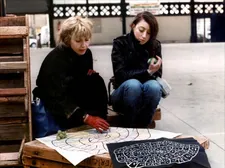 |
| Bulle Ogier and Pascale Ogier in Jacques Rivette's Le Pont Du Nord: "Like the Ackerman movie Toute Une Nuit, like something like La Fille Seule - there are movies that are crossing time." |
AKT: That goes with what we talked about earlier, wanting the actors in the best light. For Rivette, you chose La Bande des quatre to be shown in the program at the FI:AF. This film I remember seeing when it came out. A girlfriend of mine at the time was obsessed with this film and we watched it many times. I haven't seen it since. I do remember loving the film's internal light.
CC: The light is coming from Bulle Ogier and from these four girls. Yes, it was like a girl movie. And Rivette was very fond of girls. He was a bit girly director. In all his movies, you see. Even with that one, even with Céline Et Julie [Celine And Julie Go Boating], he likes the girly situation. We were six or seven women together with Jacques working hard.
I think it was the reason your friend can feel that. For me it was my first time in DP. I like the movie, it's a contrast movie. The faces are very lit, really lit. I chose it because I made a restoration of this movie. Also Jacques Rivette died, so it was making a tribute to him.
AKT: You also did Le Pont Du Nord with him, which is such a great film!
CC: Le Pont Du Nord, it's a beautiful poetic movie. It was very very low budget. No inside set.
AKT: Yeah, everything takes place outside all over Paris.
_225.webp) |
| Chantal Akerman's Now (2015) opens at the Jewish Museum in New York on January 21 |
CC: Everything outside because of the budget. Shot in Super 16 and we made a restoration of this movie. Just before coming to New York I went with Bulle Ogier to present it in Lyon in the Fête des lumières. It had a good success. It's very interesting to see the movie crossing time. Like the Ackerman movie Toute une nuit, like something like La fille seule - there are movies that are crossing time. Definitely Le Pont Du Nord crosses time.
AKT: The games are so memorable.
CC: It's very Rivette that.
AKT: You worked with Kevin Macdonald on a Howard Hawks documentary. He is the grandson of Emeric Pressburger.
CC: Yes. It was very interesting. It was not the Samuel Fuller one … No, it was Kevin for the BFI. I've made two movies for the BFI.
AKT: The other one was on Samuel Fuller, Adam Simon's The Typewriter, The Rifle And The Movie Camera ….
CC: Yes, it was with Tim Robbins. The Howard Hawks [: American Artist] one was the very first time filming for Kevin Macdonald.
Chantal Akerman's Now (2015) opens at the Jewish Museum in New York on January 21








